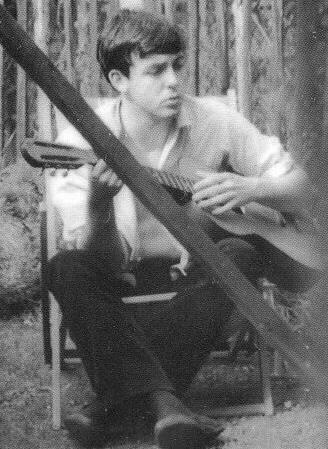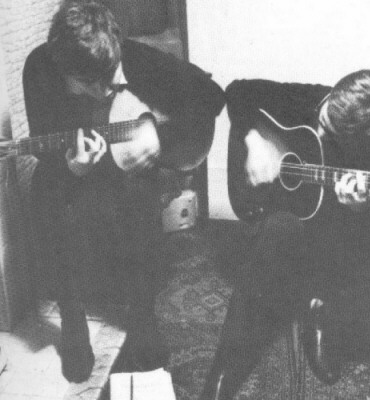The Guitarist
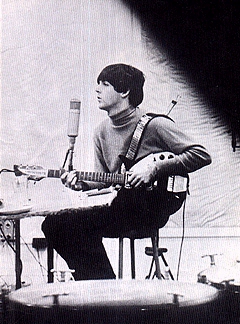 Although primarily known for his bass
playing, Sir Paul McCartney started his rock and roll
career on a six-string guitar. When he met John
Lennon at the St. Peter's Parish Fete on 6 July 1957,
he impressed the leader of The Quarry Men by knocking
out a dead-on version of "Twenty Flight Rock."
McCartney was soon offered a job with the band and
after a few practices debuted at the New Clubmoor
Hall, Norris Green, Liverpool on 18 October
1957. "I kind of went in first of all as lead
guitarist really," McCartney says in the Tony Bacon interview
from The Bass Book, "because I
wasn't bad on guitar. And when I wasn't on stage I was
even better. But when I got up on stage at the
very first gig I totally blew it -- I had never
experienced these things called nerves before."
After cocking up his solo on "Guitar Boogie Shuffle,"
he decided to "lean back" and play rhythm.
(Significantly, in an effort to impress Lennon after
this disastrous outing, McCartney showed him a song
he'd written, "I Lost My Little Girl," which prompted
Lennon to show McCartney a few songs he'd written --
launching a formidable songwriting partnership.)
Before long McCartney nominated his mate George
Harrison for lead duties, and continued playing rhythm
through the second Hamburg trip in early 1961, Although primarily known for his bass
playing, Sir Paul McCartney started his rock and roll
career on a six-string guitar. When he met John
Lennon at the St. Peter's Parish Fete on 6 July 1957,
he impressed the leader of The Quarry Men by knocking
out a dead-on version of "Twenty Flight Rock."
McCartney was soon offered a job with the band and
after a few practices debuted at the New Clubmoor
Hall, Norris Green, Liverpool on 18 October
1957. "I kind of went in first of all as lead
guitarist really," McCartney says in the Tony Bacon interview
from The Bass Book, "because I
wasn't bad on guitar. And when I wasn't on stage I was
even better. But when I got up on stage at the
very first gig I totally blew it -- I had never
experienced these things called nerves before."
After cocking up his solo on "Guitar Boogie Shuffle,"
he decided to "lean back" and play rhythm.
(Significantly, in an effort to impress Lennon after
this disastrous outing, McCartney showed him a song
he'd written, "I Lost My Little Girl," which prompted
Lennon to show McCartney a few songs he'd written --
launching a formidable songwriting partnership.)
Before long McCartney nominated his mate George
Harrison for lead duties, and continued playing rhythm
through the second Hamburg trip in early 1961, 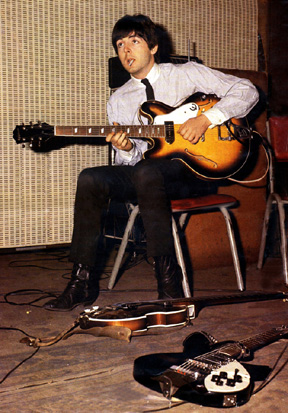 when he was called upon to replace
struggling bassist Stuart Sutcliffe. From that point
he would provide virtuoso bass accompaniment for The
Beatles throughout their career. when he was called upon to replace
struggling bassist Stuart Sutcliffe. From that point
he would provide virtuoso bass accompaniment for The
Beatles throughout their career.
From his first solo album McCartney has
stepped out from behind the bass and displayed his
considerable talent playing six-string guitar, but few
fans realized during the Beatles' recording years that
McCartney was providing some of the tastiest guitar
playing to be heard on those records, rivaling Lennon
in spirit and Harrison in technique. His solos
can be heard on, among other songs, "Taxman," "Drive
My Car," "The End," "Good Morning, Good Morning" and
"Helter Skelter." Now this musician, who brought
a new spirit and prestige to bass guitar, is being
appreciated belatedly for his six-string work.
|
 Although primarily known for his bass
playing, Sir Paul McCartney started his rock and roll
career on a six-string guitar. When he met John
Lennon at the St. Peter's Parish Fete on 6 July 1957,
he impressed the leader of The Quarry Men by knocking
out a dead-on version of "Twenty Flight Rock."
McCartney was soon offered a job with the band and
after a few practices debuted at the New Clubmoor
Hall, Norris Green, Liverpool on 18 October
1957. "I kind of went in first of all as lead
guitarist really," McCartney says in the Tony Bacon
Although primarily known for his bass
playing, Sir Paul McCartney started his rock and roll
career on a six-string guitar. When he met John
Lennon at the St. Peter's Parish Fete on 6 July 1957,
he impressed the leader of The Quarry Men by knocking
out a dead-on version of "Twenty Flight Rock."
McCartney was soon offered a job with the band and
after a few practices debuted at the New Clubmoor
Hall, Norris Green, Liverpool on 18 October
1957. "I kind of went in first of all as lead
guitarist really," McCartney says in the Tony Bacon  when he was called upon to replace
struggling bassist Stuart Sutcliffe. From that point
he would provide virtuoso bass accompaniment for The
Beatles throughout their career.
when he was called upon to replace
struggling bassist Stuart Sutcliffe. From that point
he would provide virtuoso bass accompaniment for The
Beatles throughout their career. 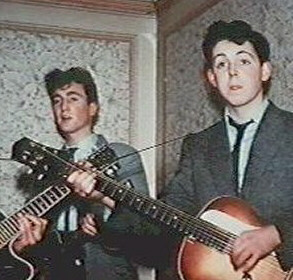 1956: Zenith Model 17 acoustic, vintage
unknown: In June 1956, McCartney's father gave him a
trumpet for his fourteenth birthday. "I used to
play it a little bit," he recalls in Many Years
From Now, the Barry Miles biography,
"because that was the hero instrument then, The
Man with the Golden Arm and everything, but
it became clear to me fairly quickly that you couldn't
sing with a trumpet stuck in your mouth."At the same
time, skiffle-band fever was sweeping England, and after
getting his dad's permission, young McCartney brought
the trumpet back to Rushworth and Dreaper's Music, where
he traded it in for this model made in Germany by
Framus.
1956: Zenith Model 17 acoustic, vintage
unknown: In June 1956, McCartney's father gave him a
trumpet for his fourteenth birthday. "I used to
play it a little bit," he recalls in Many Years
From Now, the Barry Miles biography,
"because that was the hero instrument then, The
Man with the Golden Arm and everything, but
it became clear to me fairly quickly that you couldn't
sing with a trumpet stuck in your mouth."At the same
time, skiffle-band fever was sweeping England, and after
getting his dad's permission, young McCartney brought
the trumpet back to Rushworth and Dreaper's Music, where
he traded it in for this model made in Germany by
Framus. 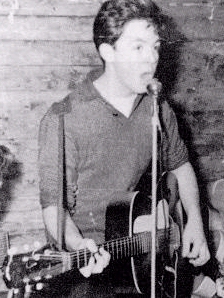 When he got home with the £15
guitar, he "couldn't figure out at all how to play it. I
didn't realize it was because I was left-handed, and it
wasn't until I saw a picture of Slim Whitman, who was
also left-handed, and I saw that I had the guitar the
wrong-way round." Once he re-strung the guitar
"upside-down," McCartney discovered that the first
string rattled around in the wider notches designed for
the sixth string, so he carefully shaved down a safety
match and made a little block to keep the string from
moving about. Later he mounted a little pickup
near the bridge, and eventually removed the pickguard,
and used this guitar until the Beatles' first trip to
Hamburg. The Zenith, on which McCartney composed
his earliest songs, including "When I'm 64," still hangs
in his studio; he pulled it down for the "Anthology"
video to play a bit of "Twenty Flight Rock."
When he got home with the £15
guitar, he "couldn't figure out at all how to play it. I
didn't realize it was because I was left-handed, and it
wasn't until I saw a picture of Slim Whitman, who was
also left-handed, and I saw that I had the guitar the
wrong-way round." Once he re-strung the guitar
"upside-down," McCartney discovered that the first
string rattled around in the wider notches designed for
the sixth string, so he carefully shaved down a safety
match and made a little block to keep the string from
moving about. Later he mounted a little pickup
near the bridge, and eventually removed the pickguard,
and used this guitar until the Beatles' first trip to
Hamburg. The Zenith, on which McCartney composed
his earliest songs, including "When I'm 64," still hangs
in his studio; he pulled it down for the "Anthology"
video to play a bit of "Twenty Flight Rock."